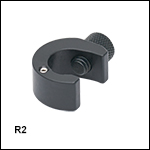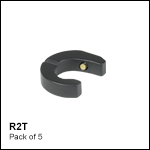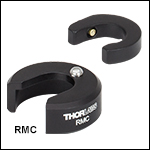Slip-On Ø1/2" Post Collar

- Slip-On Collars for Ø1/2" Posts
- Restrict Post Height or Rotation Orientation
- Exchange Components While Maintaining Alignment
KS2 Ø2" Mirror Mount on Ø1/2" Post with RMC Position-Maintaining Collar
R2
0.44'' (11.2 mm) Thick with Height Adjustment
R2T
Thin, 0.23" (5.7 mm) Thick Design
RMC
Two-Piece Design Maintains Vertical and Rotational Position of a Ø1/2'' Post

Please Wait
Features
- Collars for Constraining Post Height or Rotation
- Setscrew on R2(/M) Slip-On Post Collar Offers Fine Height Adjustment
- RMC Post Collar Maintains Height and Rotational Orientation
All of the slip-on collars featured on this page are designed to maintain the established post height of an optomechanical element within a setup if removal is necessary. In addition to establishing a set post height, the two-piece RMC post collar is also capable of maintaining the rotational orientation of a post. These collars are ideally used when swapping post-mounted components, such as lenses, so that the lens' height will be aligned to the optical axis of your system. As an alternative option, rotational orientation can also be maintained using our R2 and R2T post collars if they are paired with our anti-rotation adapter.
| Posted Comments: | |
jdemuth
(posted 2017-07-11 23:29:04.377) I wanted a compact vertical post adjuster, so I took the RMC bottom, (while it is not quite right for this application, it could be adjusted easily to work) and removed the ball bearing, leaving a divot and mounted it to a post holder. I then mounted a APM03 to the post, and viola! I had an extremely compact vertical adjustment mechanism. Ideally you (Thorlabs) could slightly tweak the RMC bottom to better mate with the APM03, this would be even better, and extremely useful!!!
best,
James tfrisch
(posted 2017-08-07 11:37:24.0) Hello, thank you for contacting Thorlabs. It sounds like you are describing an alternative to APM02 with a divot. I can post this in our internal engineering forum and reach out to you directly to discuss your application. cbrideau
(posted 2015-03-09 14:02:53.253) You should offer extras of the upper portion of the RMC collar for purchase. That way you could have several different mounts preset via the upper collar, ready to be swapped out and dropped on to the lower collar on a fixed post holder. cdaly
(posted 2015-03-26 10:16:03.0) Response from Chris at Thorlabs: Thank you for your feedback. We will look into either adding these as new separate components, or possibly making the change to the R2T so that the location groove is standard. cdaly
(posted 2013-03-06 10:40:00.0) Response from Chris at Thorlabs: Thank you for using our web feedback. While this is a point at which the R2 can in fact break, this is under far more stress than the product is intended for. The collar should be sufficiently tight with a quarter turn of a hex key past hand tight. The setscrew is used for initial final positioning. Once the correct height is achieved, the post holder should be used to secure the height of the post. Once this is tight, the set screw can be retracted and the collar readjusted so a repeatable height can occur if the post is removed and reinserted into the post holder. However, if greater torque is required without the small screw, I would recommend that you consider the R2T. It is thinner profile, but has no setscrew and can handle much more toque. You'll need to use a ball driver or hex key to tighten this down as it uses an 8-32 set screw to clamp to the post, rather than the 1/4-20 thumbscrew in the R2. Thorlabs
(posted 2011-01-19 09:33:18.0) Response from Javier at Thorlabs to graum: Thank you very much for your feedback. We actually offer a few other components that are designed for mounting 1/2" posts parallel to the optical table and, at the same time, are attached to perpendicularly mounted posts. Please visit the following link: http://www.thorlabs.com/NewGroupPage9.cfm?ObjectGroup_ID=1985 graum
(posted 2011-01-18 14:03:49.0) I use a lot of R2 post collars with my 1/2" posts in lab. One thing Ive found useful is to give them an additional 4-40 tap. With this I can screw on a 1/2" post to the side, and then use this post-collar assembly to mount a post parallel to my table off of a post already mounted perpendicular to the table.
I think this would be a useful addition to anyone who wants to use these posts. It would certainly increase their value to my lab. |


Click to Enlarge
A vertical setscrew allows for fine adjustment of the post height.
- 0.44" (11.2 mm) Thick
- Includes Vertically Aligned 4-40 Setscrew
- Packs of Five Also Available
The R2(/M) Slip-On Collar locks onto a Ø1/2" post with a thumbscrew. By positioning the collar on a post so that it rests on the top of the post holder, the post can be rotated without altering the height of the mounted component. In addition, the R2 is equipped with a 4-40 setscrew. By using a 0.050" (1.3 mm) hex key, this adjustment screw allows for approximately 0.25" (6.4 mm) of post height adjustment (see photo to the right) without the need for a translating post or post holder. To restrict the rotation of the post, the R2 can be paired with the TRK05 anti-rotation adapter.


Click to Enlarge
The R2T collar marks the vertical position of a post inside a post holder.
- 0.23" (5.7 mm) Thick
- Thin Design Enables Easy Incorporation in Tightly Spaced Setups
- Sold in Packs of Five
The R2T is a thinner version of the R2 Post Collar featured above and can be secured to a Ø1/2" post by turning the included 8-32 brass-tipped locking screw. By placing the collar on a post so that it rests on the top of the post holder, the post can be rotated or removed and replaced without altering the height of the mounted component. At a thickness of only 0.23", the R2T collar occupies minimal space on the post and allows any mounted component to be positioned vertically close to the post holder.
To restrict the rotation of the post, the R2T can be paired with the TRK05 anti-rotation adapter. Alternatively, each R2T has a small groove, shown in the photo to the left, that allows it to be used as an extra post collar in setups using the RMC Position-Maintaining Post Collar (available below).


Click for Details
RMC Post Collar Maintains Height and Rotational Orientation
Position-Maintaining Post Collar Usage
- Two-Piece Post Collar Maintains Height and Rotational Orientation
- Steel Ball and V-Groove Provides ≤0.5° Angular Repeatability
- Holds Height Position to within 0.010" (0.3 mm)
Thorlabs' RMC Position-Maintaining Post Collar is designed to maintain the established height and rotational orientation of a Ø1/2" Post and Post Holder within a setup. The collar is a two-piece set: a 0.47" (11.9 mm) thick, engraved post holder collar and a thinner, 0.23" (5.7 mm) thick post collar. A steel ball and matching V-groove combination provide ≤0.5° angular repeatability.
As seen in the animation to the right, to use the RMC, slip the post holder collar on top of a Ø1/2" post holder and then secure its position using a 5/64" (2 mm) hex key to tighten the 8-32 nylon-tipped setscrew. Then, set the post height position by seating the post collar such that the V-groove sits on top of the protruding steel ball (see the image to the right). Secure the post collar to the post using a 5/64" (2 mm) hex key to tighten the brass-tipped 8-32 setscrew. Once assembled, small rotational adjustments can be achieved by loosening the setscrew in the lower collar and rotating until the desired position is reached.
The RMC post collar can be used to quickly swap optomechanical components between different posts while keeping the same height and rotational orientation. Each component to be swapped should be fitted with the post collar at the desired height. For best results, the post holder collar should be positioned so that the setscrew is opposite the spring-loaded thumbscrew (as shown in the image to the right). While making adjustments to the rotational position of the bottom collar, ensure that there is a preload from the post holder’s thumbscrew against the post; this ensures that the two-line contact between the post holder and mating post is maintained during the adjustment.
 Products Home
Products Home










 Zoom
Zoom


 Slip-On Collar
Slip-On Collar